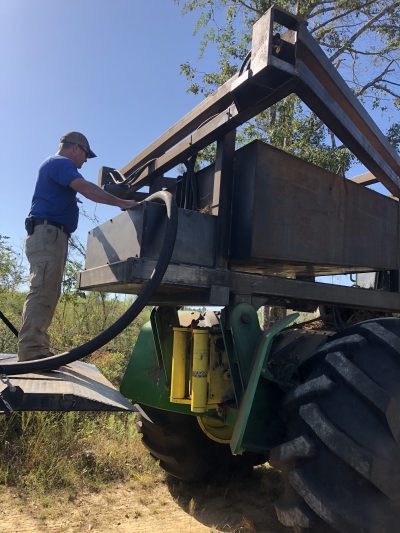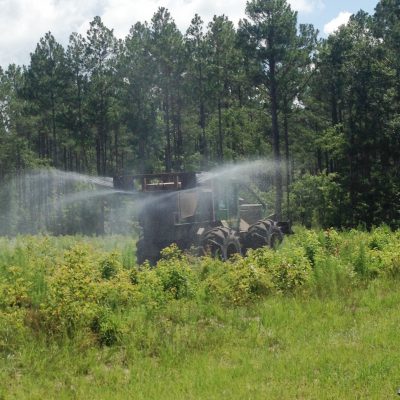With the first timber planting season post Hurricane Michael beginning in just a few months, Northwest Florida timber farmers should begin the process of aggressively prepping sites for reforestation. While the majority of site prep work that has been focused on salvage logging in the months following Michael, it’s still important to make site preparation plans for the coming years. Quality site preparation to control competition is one of the most important practices a timber grower can employ, as even a relatively small amount of woody competition can severely limit yield in mature pine stands.

Ground spray rig loading up for herbicide application. Photo courtesy Will Leonard, Deerpoint Timber Solutions.
Advantages of Chemical Site Prep with Herbicides
There are several options landowners can utilize to prepare planting sites – prescribed fire, mechanical prep with equipment, and chemical treatment. All of these options have merit in certain situations, but the most common practice in the Panhandle flatwoods to control competition for newly planted pines continues to be chemical site preparation with herbicides. Chemical site prep provides the following advantages for timber growers over either mechanical prep or prescribed fire as it:
- Effectively kills a broad array of competing plants
- Can be selective, only killing targeted vegetation, if proper timing, dosage and formulations are used
- Prevents delayed stump and root sprouting of persistent vegetation and is highly effective at controlling hardwood competition unlike mechanical or fire applications, which often allow for hardwood regrowth
- Doesn’t disturb the soil or affect site productivity due to mechanical compaction, etc.
- Works equally well on both small and large tracts
- Much more cost-effective than other applications, from $50-100 per acre depending on the prescription
–
Which Herbicides to Use?
In the hurricane affected counties (with the exception of Jackson, which contains more well-drained upland sites), the majority of timber is grown in flatwoods-type conditions where the dominant pine seedling competition is a mix of waxy-leaved shrub and tree species (yaupon holly, waxmyrtle, gallberry, sweetgum, etc.). In these settings, a tank mix of imazapyr (Arsenal AC, Chopper, or generic imazapyr product) and triclopyr (Garlon or generic triclopyr product) applied at labeled rates is very effective and provides both rapid kill of competing broadleaves into the planting season and lasting residual control well into the first growing season. On upland or sandier sites with different major competing species like oaks or grasses, products like sulfometuron (Oust XP), metsulfuron (Escort, MSM), glyphosate (Accord XRT or generic glyphosate product), and hexazinone (Velpar L or generic hexazinone product) are also in the grower’s toolbox and may be used according to the label and specific situation. For example, Velpar works well in sandier soil textures and provides excellent control where oak is a problem species. Again, one of the advantages of using herbicides in a quality site prep program is the ability to tailor the mix of chemistries to the site to achieve the best outcome. To best utilize this advantage, consider hiring an experienced forester that is well-versed in developing herbicide prescriptions based on site conditions.
–

Imazapyr + Triclopyr tank mix ground application in Walton County, FL. Photo courtesy Will Leonard, Deerpoint Timber Solutions.
When and How to Apply?
Chemical site prep contractors generally begin spray programs in summer (June) and continue through the first frost (late October). It should be noted that applications of tank mixes containing imazapyr near the end of October or later, while still very effective at controlling hardwood species, may interfere with pine seedling growth as a result of residual imazapyr soil activity and should be avoided if possible . Site prep herbicides are delivered through one of two means: ground or aerial application. Application method is primarily determined by site conditions. Most spray contractors prefer ground application, as it is more precise and allows for more gallons per acre (GPA) of water to be used, greatly reducing potential for herbicide drift and the potential to damage to non-target sites. On wetter sites where heavy ground equipment will either negatively impact soil conditions or be unable to operate, applications are made aerially.
–
Drawbacks to Chemical Site Prep
If used properly, from an agronomic perspective, there are few drawbacks to a chemical site prep program. However, there are a few possible negative outcomes of forestry herbicide applications:
- Non-target species injury if label rates and application timing considerations are not followed
- Potential for uneven effects across large tracts due to species diversity and their sensitivity to the tank-mixed herbicides
- Time – forestry herbicides are most effective when competition is allowed to grow a year or more after harvest
- Leaving unsightly standing woody material (hardwoods left after logging and subsequently killed by herbicides)
- Weather condition dependent (drought and temperature may affect herbicide effectiveness)
- Some social controversy associated with chemical herbicide use
Though no one method is perfect, chemical site prep is the predominant method used for pine plantation establishment in the Panhandle for good reason. It is more cost effective than mechanical prep, has less associated liability than prescribed fire, can be tailored to fit any site’s conditions and competitive species, and ultimately buys the grower’s crop of trees a head-start on woody plant competition for the critical first two to three years of establishment. After the devastation by Hurricane Michael, Panhandle timber growers need to use all the tools at their disposal to reforest cost-effectively and rapidly and chemical site prep is one of the strongest options in the toolbox.
–
References
Will Leonard, Deerpoint Timber Solutions
Dickens, D., P. Minogue and D. Moorhead. 2012. A guide to using imazapyr for chemical site preparation in southern pine plantation establishment. University of Georgia, CAES and WSFNR.
Dickens, D., Minogue, P., and Moorhead, D. 2018. Pre-plant Chemical Site Preparation Options to Establish Loblolly, Longleaf, and Slash Pine Plantations in South Georgia and North-Central Florida.
- Stay Ahead of Peanut Fungal Pathogens This Summer - August 8, 2025
- Panhandle Cotton Acres Are Down in 2025– Here’s the Reason - July 11, 2025
- It Snowed, But Has This Been a Historically Cold Winter? What the Data Says. - January 31, 2025
